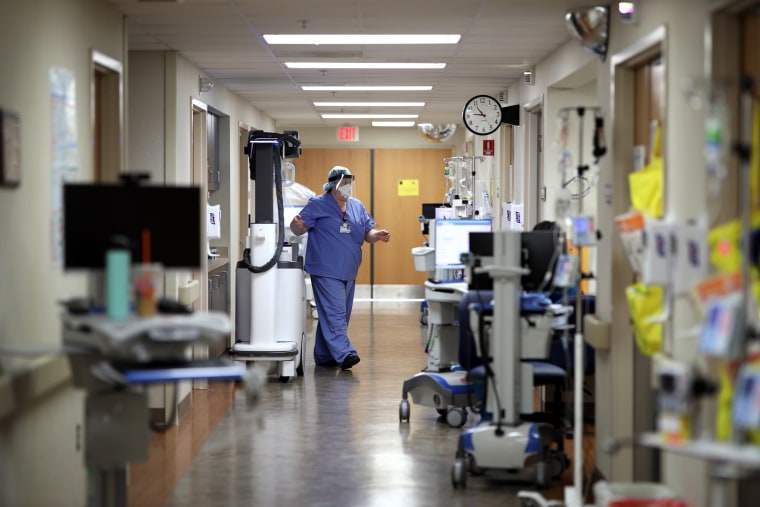On one side of the winding Potomac River, Maryland's hospitals just got a much-needed infusion of stimulus cash as they treat some 10,000 coronavirus cases. The federal help amounted to $73,986 per COVID-19 patient.
Just across the river, West Virginia has thus far been spared the worst of the pandemic, with barely 700 confirmed cases. But when the stimulus dollars arrived, West Virginia got $351,000 per case.
And across the country, children's hospitals got next to nothing, while states with higher poverty rates got less per capita than their wealthier neighbors, an NBC News analysis finds.
The gaping discrepancies are playing out across the country as Washington doles out $100 billion in emergency aid to hospitals, doctors and clinics besieged by the pandemic. The first tranche of $30 billion started going out Friday, divvied up not based on infection rates but on past Medicare spending.
"There should be some correlation between the costs health care providers are incurring for treating COVID patients and the amount of federal relief they receive. That's just common sense," said Sen. Chris Van Hollen, D-Md.
The disparities stem from the system the Health and Human Services Department used to divide up the first $30 billion. The government did not give out a specific sum per COVID case being treated. Aiming to get help to hospitals as fast as possible, officials used the most robust set of data they already had: spending levels for Medicare's fee-for-service plans.
Whatever portion of overall Medicare spending a hospital or provider received last year, they were given that same portion of the $30 billion.
That means that children's hospitals and pediatricians who don't treat older patients were essentially left out. The only children on Medicare in the U.S. are a tiny number covered by a one-off program for kids with end-stage renal disease.
"We're worried about it. We've got kids' hospitals that don't have a lot of money in the bank and are a break-even operation on a good day," said Mark Wietecha, president and CEO of the Children's Hospital Association. Hoping for a quick fix from Washington, he added, "if it winds up being a couple months, it will be catastrophic for a lot of hospitals."
States with higher rates of people on Medicaid, the federal health insurance program for low-income people, have lower rates of Medicare use, so they got lower amounts relative to their population. Obstetricians are another group largely left out, since they have fewer patients eligible for Medicare.
Seema Verma, the administrator of the Centers for Medicare and Medicaid Services, has said that all those issues "will be addressed in the second tranche of funding" and prioritized as the rest of the $100 billion is doled out.
"A significant amount of this money will go to the hospitals in hot spots," President Donald Trump added Tuesday as he met with hospital groups. He did not say how that would be calculated or provide a date, other than to say, "Soon."
But Congress, which created the $100 billion fund for hospitals, has taken note. Maryland's delegation wrote the administration Tuesday calling the failure to account for COVID-related expenses "disappointing," while New Jersey's delegation said its portion was "insufficient in the face of this global epidemic" in a letter to the leaders of the House and Senate.
Van Hollen, in an interview, said he understood why the administration took the quickest path to getting the initial aid to hospitals, but said the remaining funds must be "based on intensity of need."
"This is not where you want to use a shotgun approach," he said.
New Jersey, whose nearly 70,000 COVID-19 cases constitute about 11 percent of the U.S. total, got about $919 million, or roughly $13,000 per confirmed case. In New York, hardest hit by COVID-19 with a third of all U.S. cases, it was barely $9,000 per COVID-19 case.
But North Dakota, with 0.06 percent of coronavirus cases in the U.S., got about $267,000 per case. Louisiana, with more than 21,500 cases, got barely $22,000 per case, while just across the state line, Arkansas got $218,000 per COVID-19 case.
"How can that be?" New York Gov. Andrew Cuomo mused at one of his daily coronavirus briefings. "It can be because in the Senate, it became a game of political pork."
NBC News independently calculated how much each state received per case using a state-by-state analysis the Trump administration gave to Congress as well as NBC News' running tally of COVID cases per state. Although the number of cases in each state is changing daily, the results closely tracked an earlier analysis of the state breakdowns by Kaiser Health News.
Not all costs borne by the health care industry related to the pandemic come from treating COVID-19 patients themselves. So there may be good reason to direct some funds even to areas that don't currently have high rates of infection.
Bob Atlas, president and CEO of the Maryland Hospital Association, said hospitals lost major portions of their revenue when they cut back on lucrative elective procedures, which the U.S. Coronavirus Task Force in March urged people to postpone. At the same time, he said, costs have increased as facilities ramp up protective measures for their staff and prepare more beds.
"Everybody has been creating additional capacity, clearing out hospital space to get ready for a surge of patients," Atlas said.
CORRECTION (April 16, 2020, 8 p.m. ET): A previous version of this article misspelled the last name of the administrator of the Centers for Medicare and Medicaid Services. She is Seema Verma, not Verva.

